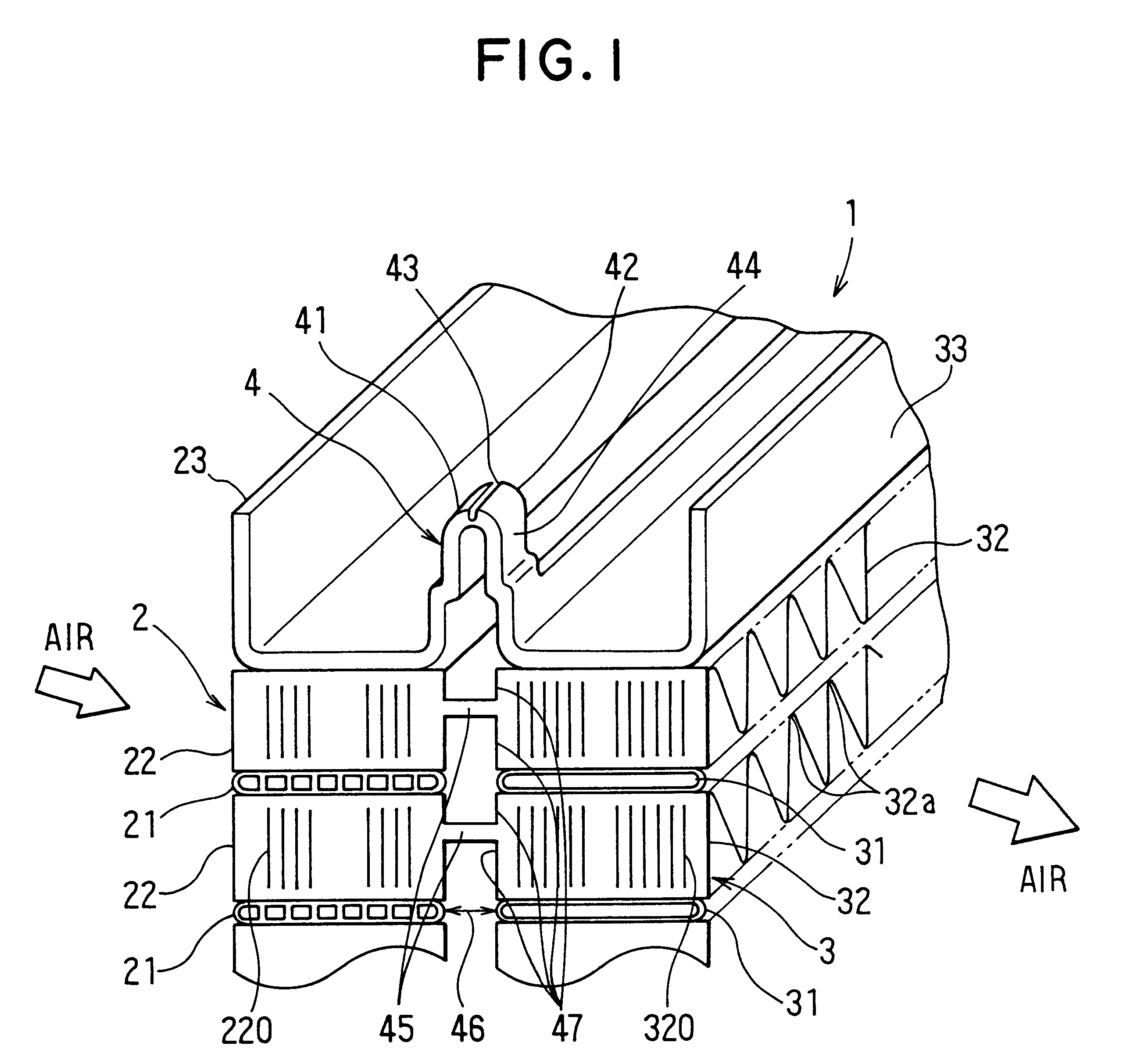Heat exchanger having several heat exchanging portions
a heat exchanger and heat exchange portion technology, applied in the field of heat exchangers, can solve the problems of reducing the loss of heat in this core portion, the above-described method of setting the fin pitch in the first and second core potions cannot be applied to this type of heat exchanger, and the inability to design each fin pitch independently
- Summary
- Abstract
- Description
- Claims
- Application Information
AI Technical Summary
Benefits of technology
Problems solved by technology
Method used
Image
Examples
first embodiment
(First Embodiment)
In an automotive heat exchanger 1 shown in FIGS. 1,2, a condenser core portion 2 of an automotive air conditioning apparatus is used as a first core portion, and a radiator core portion 3 for cooling an engine is used as a second core portion. Generally, because the temperature of refrigerant flowing through the condenser core portion 2 is lower than that of engine cooling water flowing through the radiator core portion 3, the condenser core portion 2 is disposed at the upstream air side of the radiator core portion 3 in air flow direction and the two core portions 2, 3 are disposed in series in the air flow direction at the front-most portion of an engine compartment. The structure of the heat exchanger of the first embodiment is hereinafter described with reference to FIGS. 1 through 5.
FIG. 1 is a partial enlarged cross-sectional view of a heat exchanger 1 of the present invention. As shown in FIG. 1, a condenser core portion 2 and a radiator core portion 3 are d...
second embodiment
(Second Embodiment)
According to the second embodiment, as shown in FIGS. 6A, 6B, in the condenser cooling fin 22, ten louvers 220 are provided by making the most of the space thereof. While, in the radiator cooling fin 32, six louvers 320 are provided although ten louvers can be provided thereon if desired. That is, the relation: (Nc / Lc)>(Nr / Lr) is satisfied. Thereby, the radiation amount in the radiator core portion 3 decreases, while the radiation amount in the condenser core portion 2 increases with the air flow amount increasing.
FIG. 7 shows the relations between the number of louvers decreasing ratio and the performance ratios of the core portions 2, 3 under the condition that air flow speed of the cooling air is constant. Here, the number of louvers decreasing ratio is defined as a ratio of the number of louvers decreased relative to the number of louvers which can be provided within the predetermined fin width Lc, Lr. For example, in the condenser cooling fin 22 shown in FIG....
third embodiment
(Third Embodiment)
According to the third embodiment, as shown in FIGS. 8A, 8B, a projection portion 326 is formed at the air upstream side end (the end facing the condenser core portion 2) of the radiator cooling fin 32. This projection portion 326 protrudes from the end of the radiator tube 31 toward the air upstream side. Thereby, the number of louvers Nr in the radiator cooling fin 32 is increased more than that in the first embodiment.
For example, as shown in FIGS. 8A, 8B, the radiator cooling fin 32 has twelve louvers 320. Thus, a radiation amount difference between in the condenser core portion 2 and in the radiator core portion 3 is expanded more than in the first embodiment.
PUM
 Login to View More
Login to View More Abstract
Description
Claims
Application Information
 Login to View More
Login to View More - R&D
- Intellectual Property
- Life Sciences
- Materials
- Tech Scout
- Unparalleled Data Quality
- Higher Quality Content
- 60% Fewer Hallucinations
Browse by: Latest US Patents, China's latest patents, Technical Efficacy Thesaurus, Application Domain, Technology Topic, Popular Technical Reports.
© 2025 PatSnap. All rights reserved.Legal|Privacy policy|Modern Slavery Act Transparency Statement|Sitemap|About US| Contact US: help@patsnap.com



